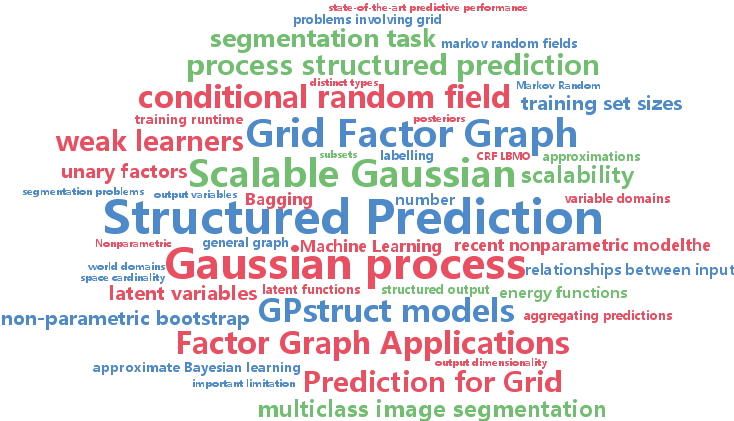structured prediction
-
Sebastien Bratieres and Novi Quadrianto and Sebastian Nowozin and Zoubin Ghahramani
Scalable Gaussian Process Structured Prediction for Grid Factor Graph Applications (pdf)
Structured prediction is an important and well studied problem with many applications across machine learning. GPstruct is a recently proposed structured prediction model that offers appealing properties such as being kernelised, non-parametric, and supporting Bayesian inference (Bratières et al. 2013). The model places a Gaussian process prior over energy functions which describe relationships between input variables and structured output variables. However, the memory demand of GPstruct is quadratic in the number of latent variables and training runtime scales cubically. This prevents GPstruct from being applied to problems involving grid factor graphs, which are prevalent in computer vision and spatial statistics applications. Here we explore a scalable approach to learning GPstruct models based on ensemble learning, with weak learners (predictors) trained on subsets of the latent variables and bootstrap data, which can easily be distributed. We show experiments with 4M latent variables on image segmentation. Our method outperforms widely-used conditional random field models trained with pseudo-likelihood. Moreover, in image segmentation problems it improves over recent state-of-the-art marginal optimisation methods in terms of predictive performance and uncertainty calibration. Finally, it generalises well on all training set sizes.
-
Wei Ping and Qiang Liu and Alex Ihler
Marginal Structured SVM with Hidden Variables (pdf)
In this work, we propose the marginal structured SVM (MSSVM) for structured prediction with hidden variables. MSSVM properly accounts for the uncertainty of hidden variables, and can significantly outperform the previously proposed latent structured SVM (LSSVM; Yu & Joachims (2009)) and other state-of-art methods, especially when that uncertainty is large. Our method also results in a smoother objective function, making gradient-based optimization of MSSVMs converge significantly faster than for LSSVMs. We also show that our method consistently outperforms hidden conditional random fields (HCRFs; Quattoni et al. (2007)) on both simulated and real-world datasets. Furthermore, we propose a unified framework that includes both our and several other existing methods as special cases, and provides insights into the comparison of different models in practice.
-
Hongyu Su and Aristides Gionis and Juho Rousu
Structured Prediction of Network Response (pdf)
We introduce the following network response problem: given a complex network and an action, predict the subnetwork that responds to action, that is, which nodes perform the action and which directed edges relay the action to the adjacent nodes. We approach the problem through max-margin structured learning, in which a compatibility score is learned between the actions and their activated subnetworks. Thus, unlike the most popular influence network approaches, our method, called SPIN, is context-sensitive, namely, the presence, the direction and the dynamics of influences depend on the properties of the actions. The inference problems of finding the highest scoring as well as the worst margin violating networks, are proven to be NP-hard. To solve the problems, we present an approximate inference method through a semi-definite programming relaxation (SDP), as well as a more scalable greedy heuristic algorithm. In our experiments, we demonstrate that taking advantage of the context given by the actions and the network structure leads SPIN to a markedly better predictive performance over competing methods.
-
Yujia Li and Rich Zemel
High Order Regularization for Semi-Supervised Learning of Structured Output Problems (pdf)
Semi-supervised learning, which uses unlabeled data to help learn a discriminative model, is especially important for structured output problems, as considerably more effort is needed to label its multidimensional outputs versus standard single output problems. We propose a new max-margin framework for semi-supervised structured output learning, that allows the use of powerful discrete optimization algorithms and high order regularizers defined directly on model predictions for the unlabeled examples. We show that our framework is closely related to Posterior Regularization, and the two frameworks optimize special cases of the same objective. The new framework is instantiated on two image segmentation tasks, using both a graph regularizer and a cardinality regularizer. Experiments also demonstrate that this framework can utilize unlabeled data from a different source than the labeled data to significantly improve performance while saving labeling effort.



